Out of home businesses - marketing strategies: research
A report on research using ‘mystery shoppers’ to understand price and placement marketing strategies used within premises and online by out of home businesses in Scotland. The research included observation of whether or not calorie information was present at the point of purchase.
5. Meal deals
Meal deals are typically considered to be the offering of a main (e.g. sandwich, burger, salad etc.), drink and snack. However, there are also variations used by different types of business, such as those offering a drink and a snack (e.g. a coffee and a cake) and those aimed at more than one person e.g. two mains for a discounted price.
This chapter reports on the presence of meal deals at the outlets visited. It also considers the availability of healthier options as part of a meal deal, such as water or healthier side orders.
Prevalence of meal deal promotions
Overall, meal deal promotions for one or more people were visible inside or outside just over half (54%) of the outlets visited. Of the online mystery shops, clear meal promotions were visible in around a third (35%) of the apps or websites visited.
As shown in Figure 5.1, among the in-premise visits, there was some variation by outlet type. Promotions were observed at most supermarkets (92%) and in the majority of convenience outlets (67%) and QSRs (62%), and around half of Bakery outlets (52%). Meal promotions were least prevalent at coffee shops (9%). Of the coffee shop brands, there were no clear meal deal promotions at Caffe Nero or Starbucks Coffee. Pret A Manger, categorised as a bakery, also had no clear meal deal promotions.
Independent outlets were less likely than average to have meal deal promotions (32%).
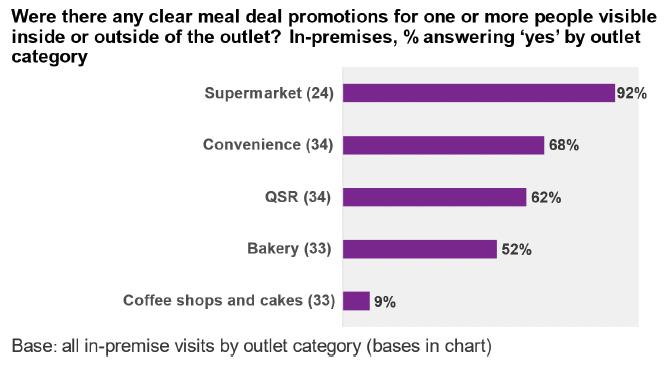
Among online visits, promotions were observed at half of bakeries (50%) and half of QSRs (50%). No meal deal promotions were available at coffee shops.
Advertising meal deal promotions
Figure 5.2 shows the relative popularity of the different ways in which meal deals were advertised. The most popular being by signage inside the outlet on fridges, shelves or by the products (55% of meal deal promotions in-premise). Other commonly sighted advertisements included signage near the till area (26%) and signage on the walls inside the outlet (25%). Advertising of meal deals was most commonly observed inside the outlet rather than outside or in the window.
Digital display adverts were more common in QSRs, where almost a third (32%) advertised them in this way, compared to 12% overall.
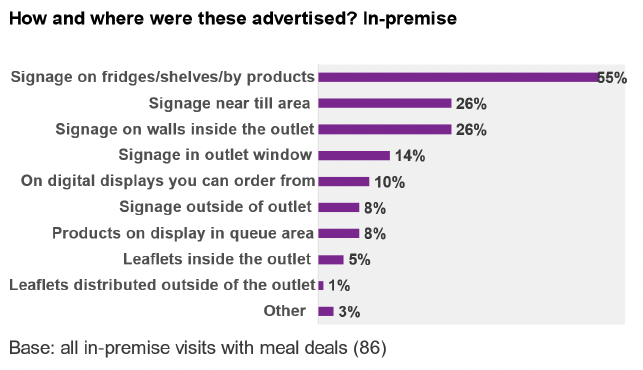
Figure 5.3 shows the way meal deals were advertised online. In 57% of cases, they were advertised on the outlet's homepage. In fewer cases, they were advertised as a pop-up or on the menu page (both 29%) or on the shopping basket or checkout page (both 14%).
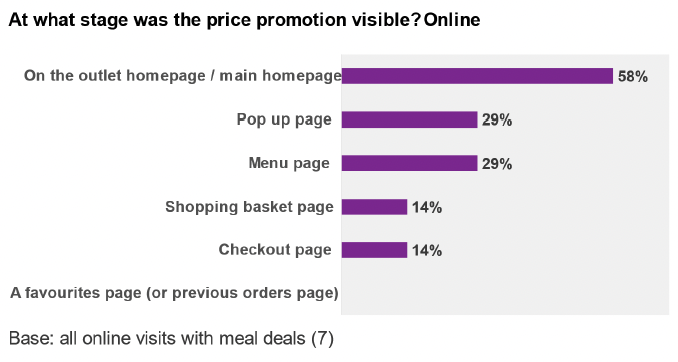
Types of meal deals
Figure 5.4 shows the relative popularity of different types of meal deals. The standard meal deal offer of a main, drink and snack was the most common deal, found at 58% of the outlets with meal deals visited in person, followed by a main, drink and side (26%) and a main and drink (21%).
Some 'other' types of meal deals included multiple main or side dish combinations (such as one main and two sides, or two mains and two snacks).
The type of meal deal on offer varied according to the type of outlet. For instance, among the in-premise visits, the main, drink and snack deal was more commonly found in supermarkets (86% of supermarkets with meal deals had these types of deals) and convenience outlets (78%) while the main, drink and side deal was more common in QSRs (81%).
The main, drink and side deal was the most common combination found online (43%). A number of 'other' meal deals were observed online, and these included meals including multiple sides or family meal bundles.
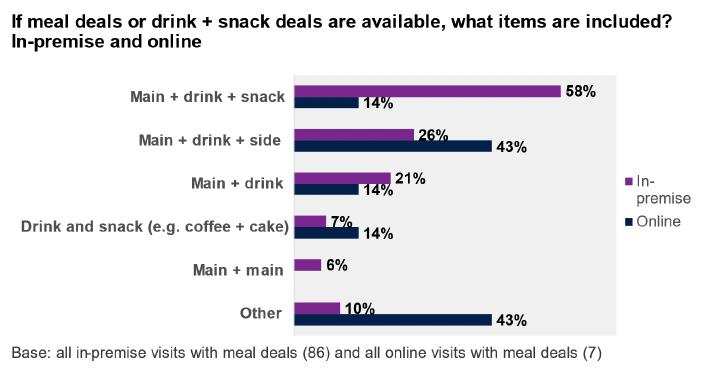
Healthier options
Healthier items were obviously available to include in meals deals in around three-quarters (76%) of outlets visited in-person. Figure 5.5 shows that water was the most common healthier alternative, available at 66% of in-premise visits while 62% offered low or no sugar drinks and 52% offered a healthier accompaniment such as fruit or salad. Plain milk was offered at 5% and 1% offered some other healthy item. In almost a quarter (24%) of outlets, no healthier items were obviously available.
In more than half (57%) of online visits, healthier items were not obviously available to include in a meal deal. In small numbers of online outlets (28%) the following healthier items were available: low/no sugar soft drinks (28%); water (14%) or fruit/vegetables/salad/dried fruit/nuts (14%). No online outlet was observed to offer plain milk or another healthy item.
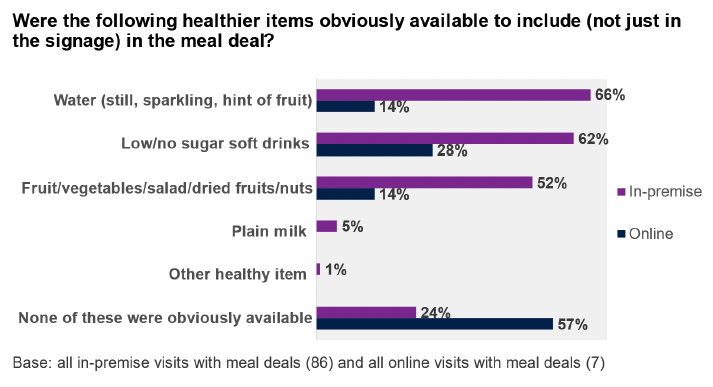
At in-person visits, the presence of obvious healthier items in meal deals was less common in coffee shops (33%) and QSRs (43%), while in supermarkets (100%) and convenience outlets (96%) there was always/almost always at least one type of healthier item obviously available as part of meal deals. Two thirds (65%) of bakeries had healthier options available in meal deals.
In terms of specific brands, the presence of obvious healthier items were less commonly available as part of meal deals at independent outlets (20% of outlets), KFC (33%) and Pizza Hut delivery (50%).
Clearly available healthier options as part of meal deals were also more commonly observed in outlets (in-person) in less deprived areas (34%) than in more deprived areas (14%).
Contact
Email: socialresearch@gov.scot
There is a problem
Thanks for your feedback